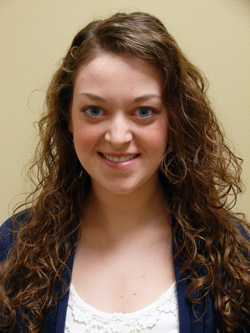Student Pilots New Language Development Measure

While many of our undergraduate students engage in research experiences, it's not often that they have the opportunity to assist in designing, evaluating, and revising a new measurement tool. Megan McKenna, a senior in the Department of Speech and Hearing Science, was fortunate to have such an opportunity, thanks to her own initiative and an outstanding mentor.
After becoming a James Scholar in her sophomore year, Megan began working in the Applied Psycholinguistics Lab with Drs. Pamela Hadley and Matthew Rispoli. With support from the National Science Foundation (BCS-0822513), the professors study the early grammatical development of children between the ages of 21 and 36 months. The researchers and their students observe and interact with parents and their children in a playroom to record language samples and to determine how children develop a mature grammatical system. It's a time-consuming process. For her James Scholar senior thesis, Megan decided to pursue her interest in children's sentence development. The traditional measure of grammatical development focuses on the length of a child's utterance. "Although length typically increases as children develop grammar, the measures of length don't capture differences in the variety of sentences children use," she explained.
Megan based her research on work by Drs. Hadley and Rispoli, in which they argue that sentences are the foundation of grammatical development and that sentence diversity, the
ability to combine a variety of verbs and sentence subjects, may be a more sensitive indicator of grammatical development than length alone. She also built upon the work of Kristin
Villa, a 2010 graduate of Speech and Hearing Science, who found that typically developing children exhibit a specific pattern of subject type expansion. They often start by using
first-person subjects, then third-person subjects, followed by other, more complex subject types. Megan and Professors Hadley and Rispoli used this information to develop a parent
report form, the Sentence Diversity Checklist (SDC) that focuses on sentence diversity. They identified diverse types of verbs that children typically produce before 30 months and combined them with different grammatical subject types to create 72 sentences. They recruited parents already participating in the NSF study of children's grammatical development, and asked the parents to check any sentence that sounded like sentences their children produced.
In Megan's pilot study, she found that the SDC validated the subject expansion pattern that Villa described and that there was a moderately strong correlation between first-person subject use reported on the SDC and first-person subject use in the child's language sample. Although Megan also found that the current design of the checklist did not effectively measure other subject types, the pilot study has provided Megan with important information needed to revise and re-evaluate the tool.
Megan will get the chance to continue working on the SDC, as she will be staying at Illinois to pursue her master's degree in speech-language pathology. Megan hopes to revise the measure and run a follow-up study to determine whether her planned revisions improve the tool and if the SDC can be used to predict upcoming changes in children's grammatical development. She credits Professor Hadley's mentorship with making the study possible and teaching her about the research process. "I think doing research as an undergraduate is a great experience, whether or not you're doing a thesis," she said. "I think we forget how applicable research is to therapies and to clinical practice."